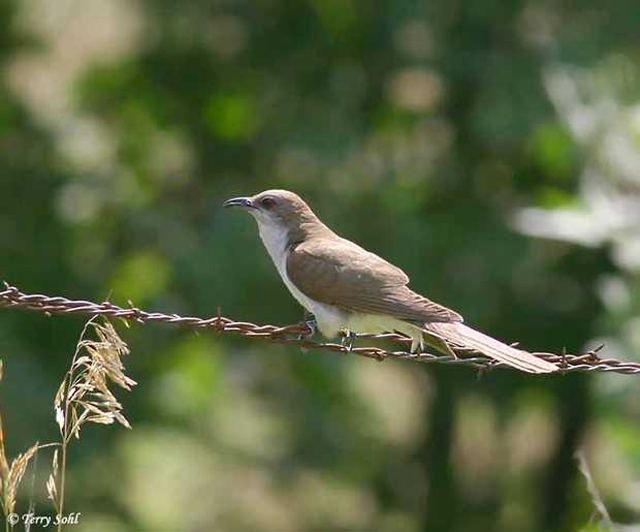The Black-billed Cuckoo is one of only a few species that feeds on hairy caterpillars such as tent caterpillars and gypsy moths. Because these caterpillars may cause serious damage to vegetation, the Black-billed Cuckoo can reduce the severity of an outbreak by consuming large quantities of these caterpillars.
Length: 28 - 30.5 cm
Physical characteristics: The Black-billed Cuckoo is a slender bird, with a long tail and a black bill. A red ring is present around the eyes in an adult. Its head, back of neck, wings and tail are brown, while its underparts are white with buff. There are distinct white tips on the tail feathers. Sexes are similar.
Voice: Song is a clear whistled, cu-cu-cu or cu-cu-cu-cu, often repeated in a rapid succession.
Physical characteristics: The Black-billed Cuckoo is a slender bird, with a long tail and a black bill. A red ring is present around the eyes in an adult. Its head, back of neck, wings and tail are brown, while its underparts are white with buff. There are distinct white tips on the tail feathers. Sexes are similar.
Voice: Song is a clear whistled, cu-cu-cu or cu-cu-cu-cu, often repeated in a rapid succession.
Breeding habitat:
This species frequents deciduous coniferous forests, areas with dense shrubby undergrowth, thickets and open woodlands. It is sometimes associated with water.
Mating system:
Believed to be monogamous; because of the rapid development of the chicks, this species may have two or more broods per season. This species will occasionally parasitize the nests of other birds - particularly the Yellow-billed Cuckoo, or more rarely those of other species especially when food is abundant.
Nest:
The nest is a large, loosely built platform, often built quite close to the ground. It is constructed of twigs, grass and weed stems and lined with fine grass, leaves and flowers.
Eggs:
The female lays 2 - 3 eggs that are light blue-green in color. 27mm (1.1 in). A larger clutch may be laid in times of caterpillar outbreaks.
Chick development:
The young hatch asynchronously after 10 to 13 days of incubation by both the male and female. The chicks are born altricial, but develop rapidly. They can leave the nest one week after hatching and fly by three weeks. Both sexes care for the young, who fledge at 7 - 9 days of age.
Diet:
This cuckoo consumes insects (chiefly hairy caterpillars) which it gleans from the leaves, branches and trunks of trees. Fish, small vertebrates, bird eggs, fruit and berries also make up its diet.
Conservation Biology:
Although still relatively common in the East, the general population of the Black-billed Cuckoo has decreased.
Region: On the North Carolina Natural Heritage Program List of Rare Animals as 'Significantly Rare' (2001) and on the Tennessee Natural Heritage Program's 'Tracked' list (2001).
Breeding: The Black-billed Cuckoo is found in the southeastern corner of Canada and the northeastern portion of the United States - from Montana in the west, south to northern Oklahoma, to some areas of Tennessee and North Carolina and north to the New England states.
Breeding: The Black-billed Cuckoo is found in the southeastern corner of Canada and the northeastern portion of the United States - from Montana in the west, south to northern Oklahoma, to some areas of Tennessee and North Carolina and north to the New England states.
The Black-billed Cuckoo is an uncommon breeding bird species in the Park. It is absent in the winter. A survey of breeding birds performed in the park, from 1996-1999, ranked Black-billed Cuckoo as the 72rd most commonly observed species (20 observations) out of 113 species recorded during the breeding seasons of the survey. Black-billed Cuckoos are most likely to be observed near the perimeter of the Park, but can occur in a variety of habitats and elevations. No individuals were recorded above 5,000 feet in the park survey.
References:
Alsop, F. J. 1991. Birds of the Smokies. Great Smoky Mountains Natural History Association, Gatlinburg, TN.
Committee on Classification and Nomenclature of the American Ornithologists' Union. 2002. Forty-third supplement to the American Ornithologists' Union Check-list of North American Birds. The Auk 119: 897-906.
Ehrlich, P. R, D. S. Dobkin, and D. Wheye. 1988. The Birder's Handbook: a Field Guide to the Natural History of North American Birds. Simon and Schuster, Inc., New York.
Elphick, C, J. B. Dunning, Jr., and D. A. Sibley, eds. 2001. The Sibley Guide to Bird Life and Behavior. Alfred A. Knopf, New York.
Gough, G. A., Sauer, J. R., Iliff, M. Patuxent Bird Identification Infocenter. 1998. Version 97.1. Patuxent Wildlife Research Center, Laurel, MD. http://www.mbr-pwrc.usgs.gov/id/framlst/infocenter.html.
J. M. Hughes. 2001. Black-billed Cuckoo. In The Birds of North America, No. 587 (A. Poole, P. Stettenheim, and F. Gill, Eds.). Philadelphia: The Academy of Natural Sciences; Washington, DC: The American Ornithologists? Union.
Sibley, D. A. 2000. The Sibley Guide to Birds. Alfred A. Knopf, New York.
Stupka, A. 1963. Notes on the birds of the Great Smoky Mountains National Park. University of Tennessee Press

